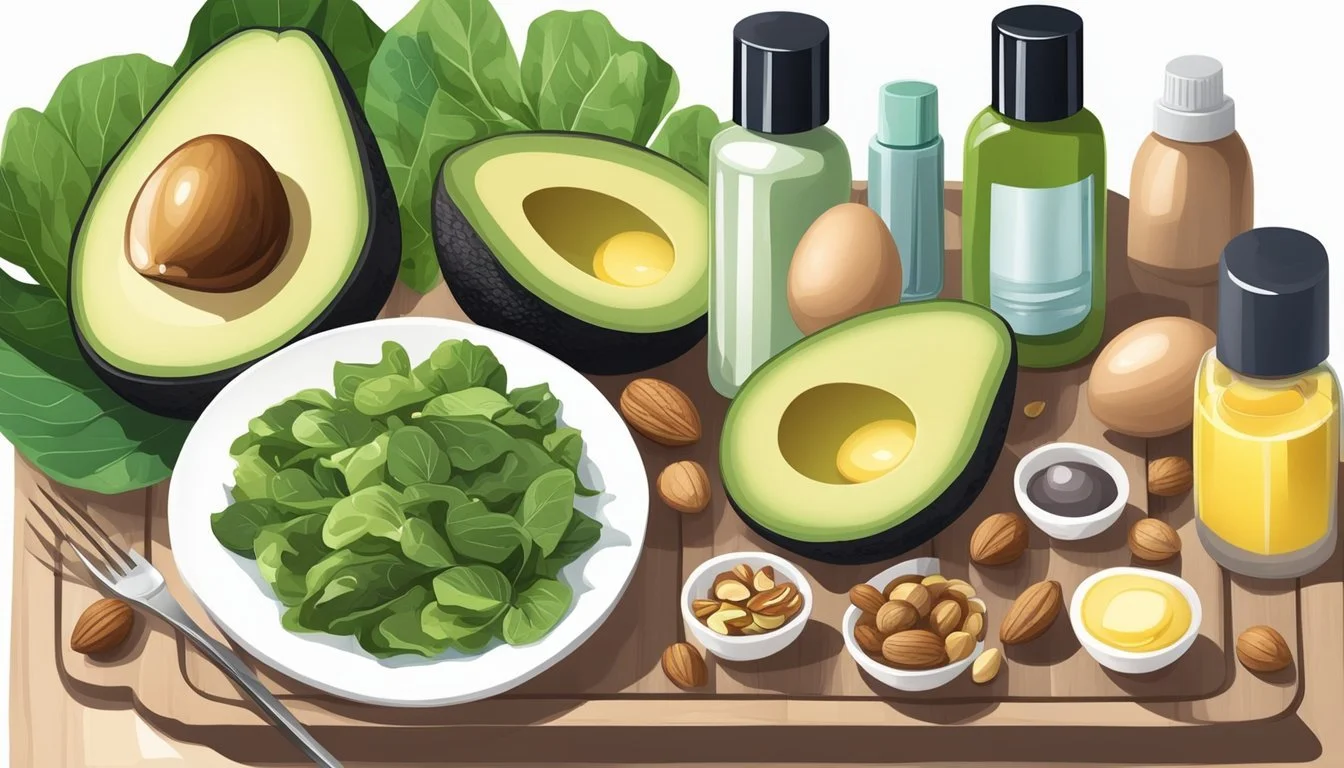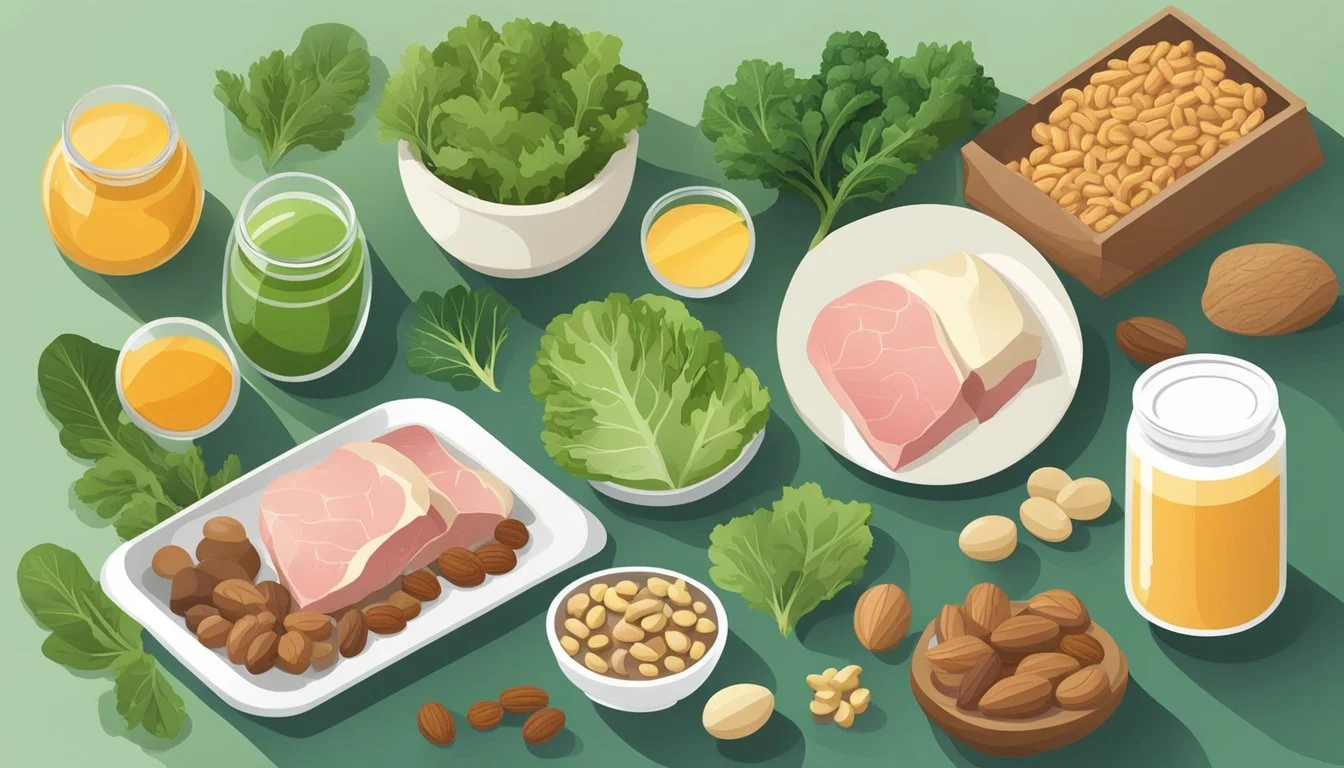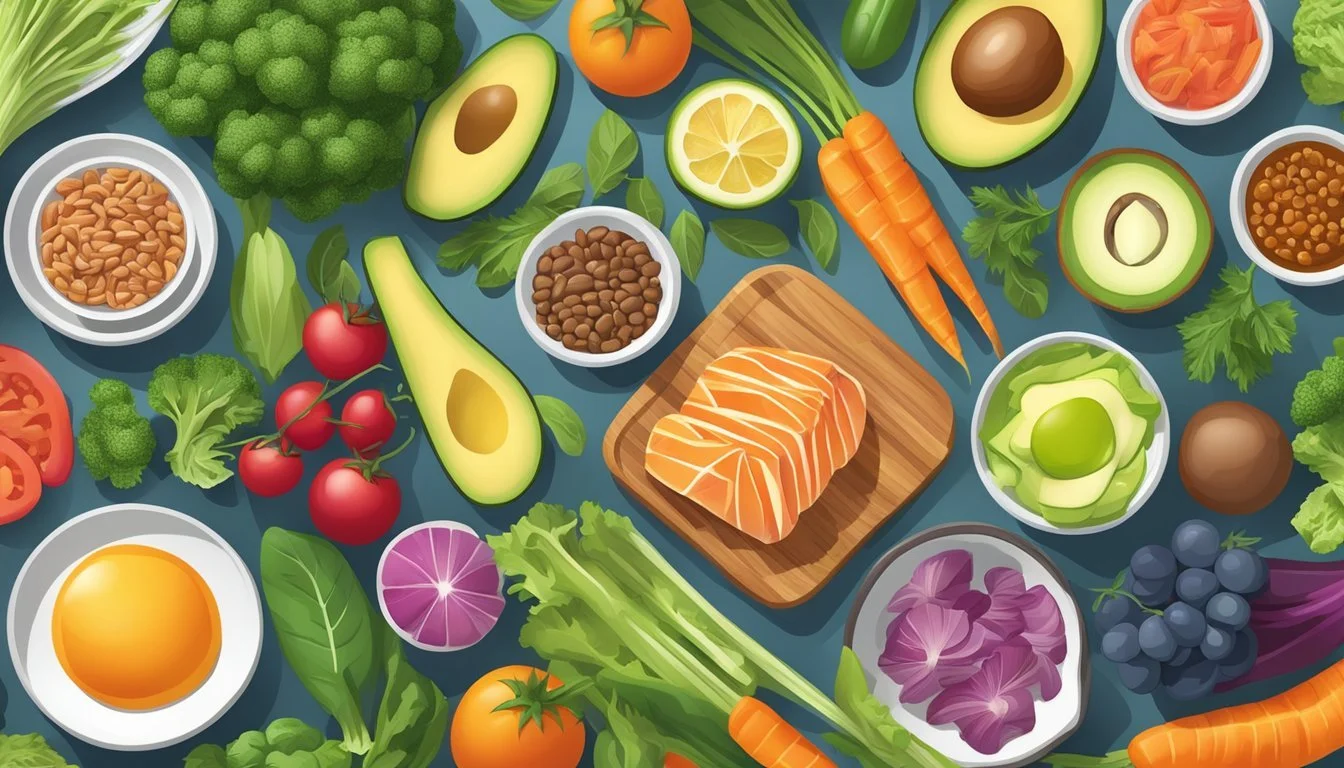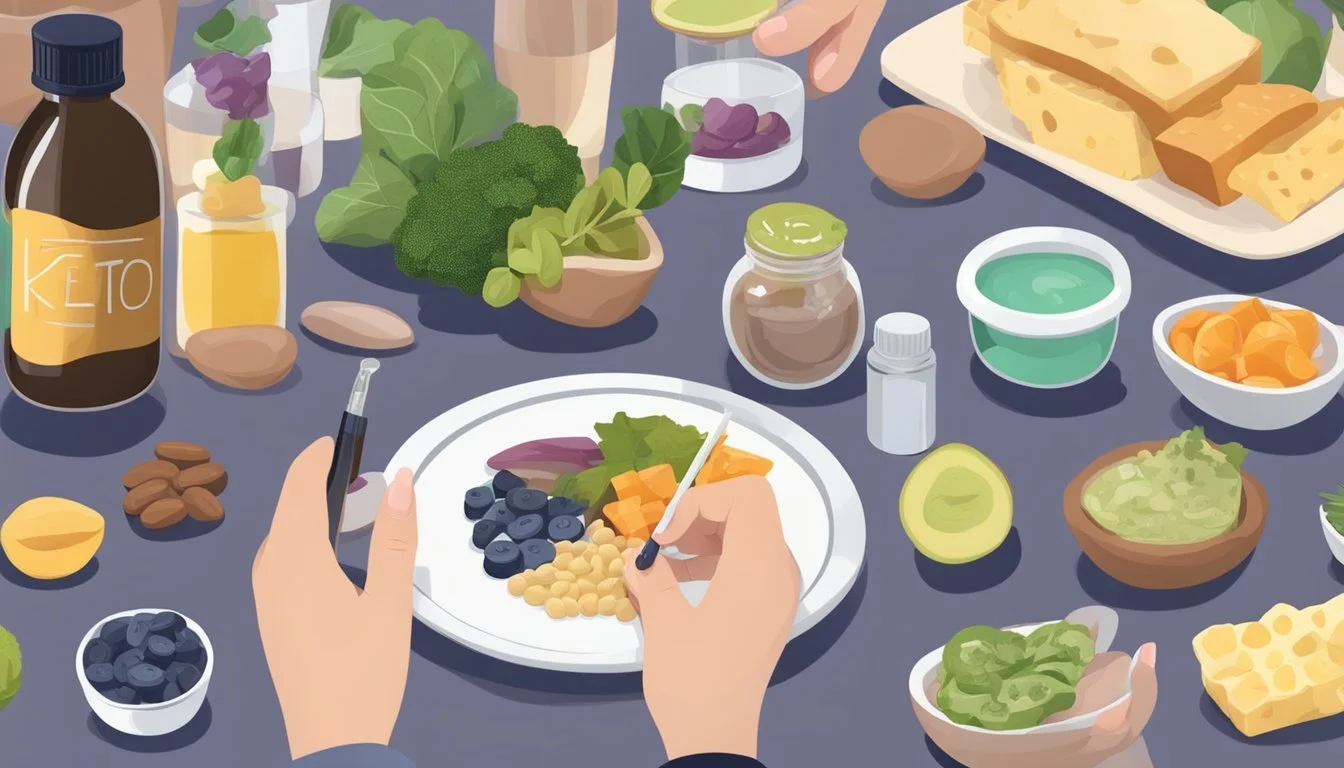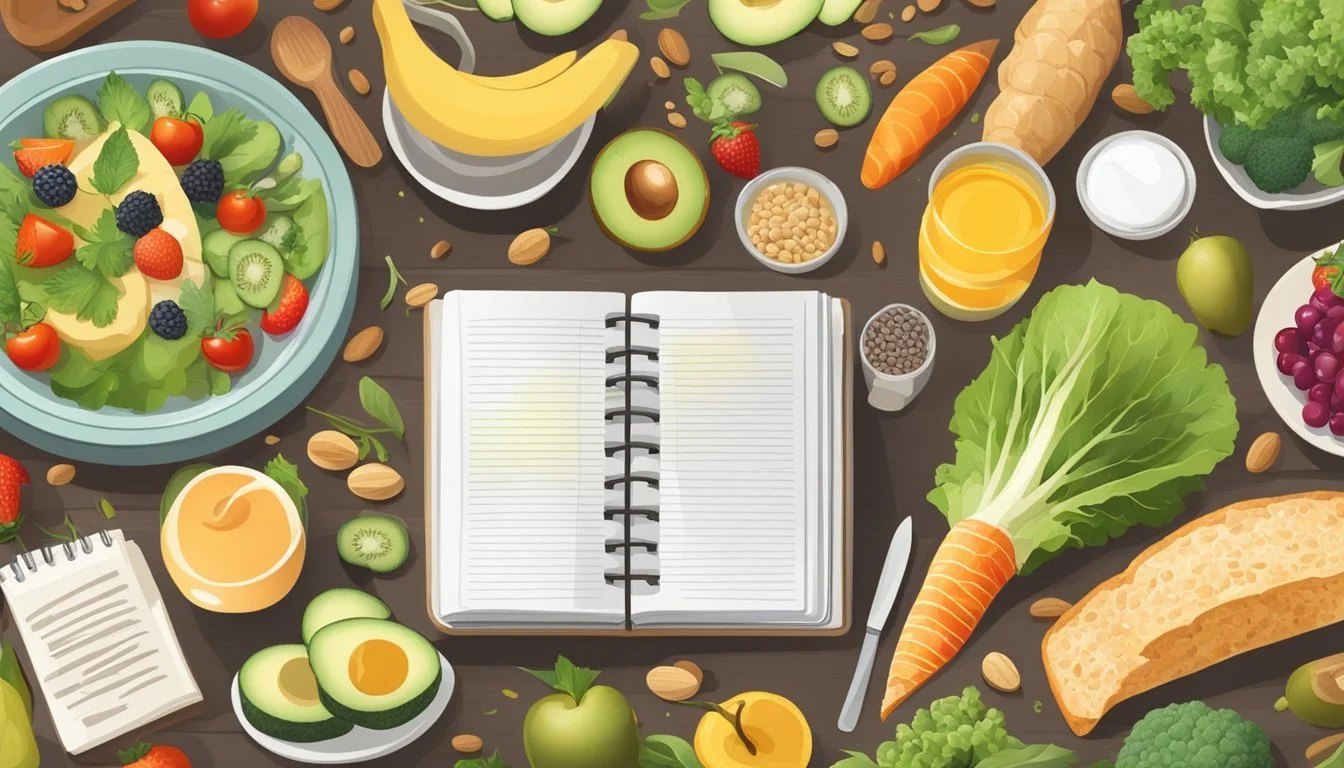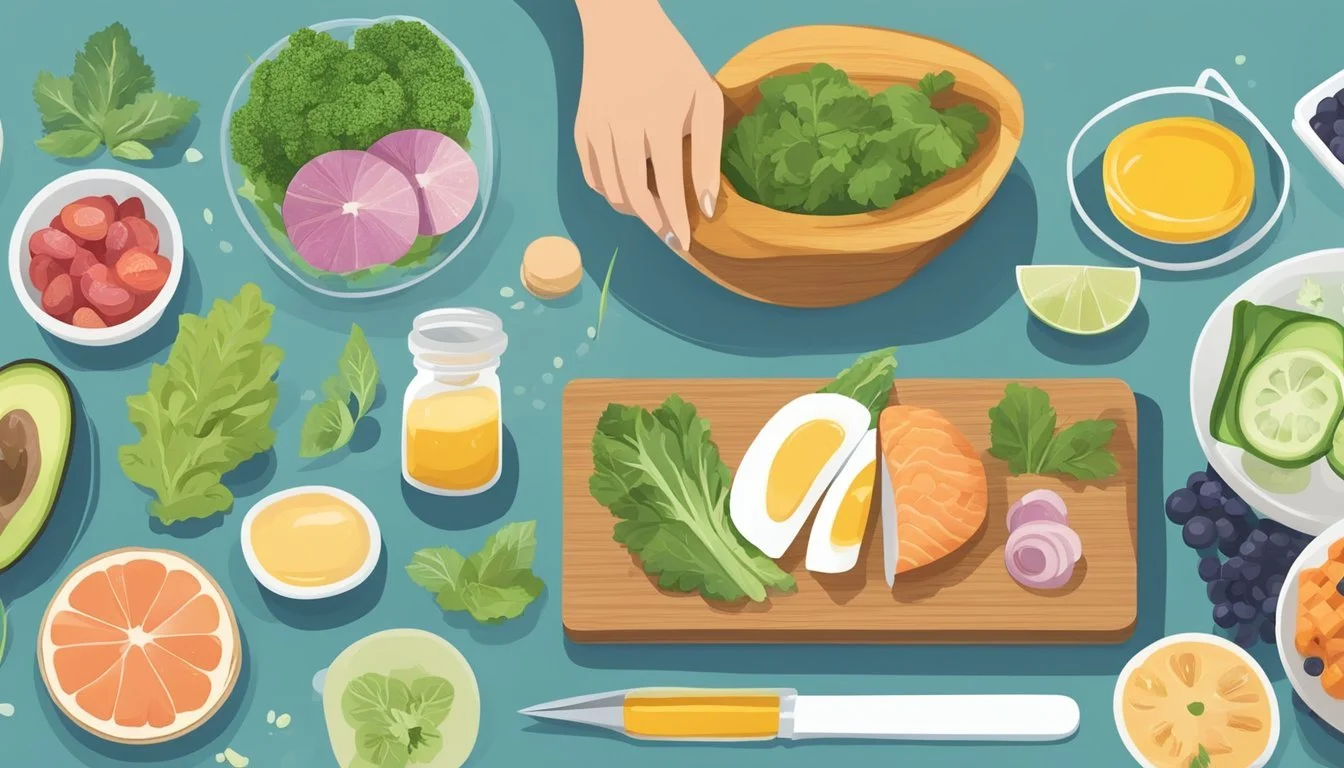Keto Diet and Nail Health
Uncovering the Connection
The ketogenic diet, commonly referred to as keto, is a high-fat, low-carbohydrate eating plan that has gained popularity for its potential benefits, including weight loss and improved blood sugar control. This diet aims to induce a state of ketosis, where the body burns fat for fuel instead of carbohydrates. However, the effects of the keto diet transcend weight management and metabolic health; they extend to various aspects of well-being, including nail health.
Nails often reflect an individual's nutritional status and overall health. A well-formulated ketogenic diet, rich in essential nutrients, may promote strong and healthy nails. It provides a significant amount of healthy fats and proteins, which are crucial for nail integrity. Among the specific nutrients playing pivotal roles are protein, vitamin D, and vitamin B12. While protein is the building block for keratin, the primary substance in nails, vitamins D and B12 are vital for absorbing calcium and maintaining nail strength.
Conversely, a deficiency in these nutrients can lead to brittle nails or hinder growth, underscoring the importance of a balanced approach to keto eating. Ensuring adequate intake of vitamins and minerals is necessary to counteract any adverse effects that restrictive diets may have on nail health. As such, personalized keto meal plans, like those developed by healthcare professionals, often emphasize the inclusion of fiber-rich vegetables and a variety of nutrient-dense foods to support overall well-being, including the health of nails.
Understanding the Keto Diet
This section delves into the ketogenic diet, emphasizing its foundational principles, how it affects bodily functions through ketosis, and an objective look at its benefits alongside the challenges it presents.
Core Principles of Keto Diet
The ketogenic diet is a high-fat, low-carbohydrate diet that significantly reduces carbohydrate intake and replaces it with fat. This dietary adjustment aims to shift the primary energy source from carbohydrates to fats. The main nutrients emphasized are high-quality fats and moderate amounts of protein, with a stringent limitation on carbohydrates.
Ketosis and Its Effects on the Body
When following the ketogenic diet, one's body enters a state called ketosis, where it burns fat for energy due to the low availability of carbohydrates. This process produces ketones, which the body uses for fuel. Achieving ketosis usually requires consuming less than 50 grams of carbohydrates per day. Initially, this transition can lead to symptoms known as the "keto flu," which may include fatigue and decreased energy levels.
Benefits and Challenges of Keto Diet
The ketogenic diet is associated with several benefits:
Weight Loss: High-fat and low-carb intake can lead to a reduction in body weight.
Blood Sugar Control: It may improve insulin resistance, beneficial for those with type 2 diabetes.
However, followers of the keto diet may face challenges such as:
Nutrient Deficiencies: Restrictive nature of the diet can lead to insufficient intake of certain nutrients.
Reduced Muscle Mass: Lower insulin levels can potentially decrease muscle mass.
Long-term Sustainability: Strict dietary limitations may be challenging to maintain over time.
Nail Health Overview
Nail health is a reflection of overall well-being, and the ketogenic diet may influence nail growth and strength, challenging the perception of what constitutes effective nutrition for nails.
Importance of Nail Health
Nails serve as both a protective barrier and a diagnostic tool, indicating the status of an individual's health. Strong, smooth nails generally reflect a healthy body, while weak or brittle nails can be symptomatic of nutritional deficiencies or underlying health issues. Nail growth is a continuous process and optimal nutrient intake is crucial for maintaining their strength and integrity.
Common Nail Health Issues
Any deviation from normal, strong nails should be noted. Common issues include:
Brittle Nails: Often a sign of dehydration or lack of moisture, but can also be indicative of nutritional deficits.
Nail Clubbing: This refers to a change where fingertips become enlarged and nails curve around them, possibly due to low oxygen levels or various diseases.
Pitting or Grooves: Can be a result of injury or skin conditions like psoriasis.
Changes in Color or Texture: May reveal fungal infections or other medical concerns.
Maintaining nail health involves a regimen of proper hygiene, balanced nutrition, and awareness of environmental factors that can impact the nails and skin surrounding them.
Nutritional Impact on Nail Health
Proper nutrition plays a crucial role in maintaining the strength and health of nails. This section will explore the specific vitamins and minerals essential for nail health and identify the signs of nutrient deficiencies as they appear in the nails.
Vitamins and Minerals Essential for Nails
Nails require an array of vitamins and minerals to remain strong and resilient. Protein is the building block of nail cells, while fats enhance their ability to absorb necessary nutrients. Key vitamins for nail health include:
Biotin (Vitamin B7): Biotin assists in the production of keratin, a protein that constitutes the nail structure.
Vitamin B12: Necessary for iron absorption, it plays a role in keeping nails strong and preventing discoloration.
Iron: Crucial for healthy red blood cells, iron delivers oxygen to nail-growing tissues.
Zinc: A deficiency in zinc can lead to the slowing of nail growth and the weakening of nail plates.
Essential minerals for nails include:
Calcium: Known for its role in bone health, calcium is also important for nails.
Magnesium: Assists in protein synthesis and the formation of new nail cells.
A balanced diet rich in these nutrients supports nail health, growth, and repair.
Signs of Nutrient Deficiencies in Nails
Nails can serve as an indicator of overall health, revealing deficiencies in essential nutrients:
Iron deficiency: May manifest as brittle nails, spoon-shaped indentations, or vertical ridges.
Protein deficiency: Can lead to thin, frail nails with a lack of luster.
Zinc deficiency: Might cause white spots on the nails and poor nail growth.
Biotin deficiency: Although rare, can lead to brittleness and thinning of the nails.
Observing these signs can prompt further investigation into a person's nutritional status and lead to adjustments in diet or supplementation to address the deficiencies.
The Role of Diet in Nail Health
Diet plays a critical role in maintaining nail health, affecting growth, strength, and texture. Specific nutrients are essential for the upkeep of healthy nails, and the dietary choices one makes can profoundly influence their condition.
Effects of Keto Diet on Nail Health
The ketogenic diet, which emphasizes high-fat, moderate-protein, and low-carbohydrate intake, can have various impacts on nail health. Lower insulin levels, a result of the keto diet, can improve insulin resistance, which is beneficial for individuals with type 2 diabetes. However, the initial phase of adapting to ketosis may lead to decreased muscle mass and reduced energy levels that could indirectly affect nail health.
Nutrients essential for healthy nails include:
Fats: A keto diet rich in healthy fats from sources like nuts, seeds, and avocado supports nail strength.
Protein: Adequate protein from eggs, fish, and red meat is crucial for nail structure.
Vitamins and Minerals: A balanced intake of vitamins and minerals is necessary. Options like spinach, broccoli, and cheese provide these nutrients.
Omega-3 fatty acids: Found in salmon, they promote nail health by reducing inflammation and nourishing nail cells.
Managing Nutrition on a Keto Diet
Individuals following a keto diet can manage their nail health by focusing their nutrition on the following:
Adequate Electrolytes: To maintain nail health, it's important to ensure sufficient intake of minerals such as calcium and magnesium, which can be found in leafy greens like spinach and seeds.
Micronutrient-Rich Foods: Including a variety of vegetables and seeds in one's diet can supply the necessary vitamins that support nail health.
Monitoring Fiber Intake: Although keto reduces carb intake, sources of fiber such as seeds and certain vegetables are still necessary for maintaining overall health, including that of the nails.
Supplementation may be considered to fill any nutritional gaps, particularly for fiber, vitamins, and minerals that support nail development and growth. It is important to ensure that one's diet is balanced and provides the comprehensive nutrition required for health and wellness.
Specific Foods and Nail Health
Nail health is directly tied to one's diet. Certain foods can strengthen and promote nail growth, while others may detract from their health.
Foods to Promote Nail Growth
Protein-Rich Foods: Protein is essential for the production of keratin, a key component of nails.
Meats: Including chicken, turkey, and red meats like beef and pork provides high-quality protein.
Fish: Salmon, tuna, and trout are not only excellent protein sources but are also rich in omega-3 fatty acids, which contribute to nail health.
Iron-Rich Foods: Iron-deficiency can lead to brittle nails.
Spinach and legumes like beans are good plant sources.
Red meat and organ meats are potent animal sources.
Vitamin & Mineral-Rich Foods:
Nuts and seeds provide zinc, which supports nail growth.
Eggs are a good source of biotin, a vitamin that encourages healthy nail growth.
Broccoli and avocados are rich in vitamins and minerals necessary for healthy nails.
Fatty Acids:
Avocados, nuts, and olive oil contain beneficial fats that aid in the absorption of vitamins and minerals, thus supporting nail health.
Foods to Avoid for Better Nail Health
High-Carb Foods: A ketogenic diet limits high-carbohydrate foods which may impact nail health if not balanced with proper nutrition.
Sugary Snacks & Beverages: These can cause spikes in blood sugar levels and don't contribute to nail strength or growth.
Refined Grains: Opt for whole grains where possible as refined grains are nutrient-poor.
Excess Dairy: Some ketogenic diets include high amounts of dairy products like cream; however, in excess, it may contribute to imbalances that affect nail health.
Remember that a balanced diet ensuring adequate intake of all necessary nutrients is crucial for nail health. It is not only about what to eat but also being mindful of foods that can impair nail vitality.
Keto Diet and General Health
The keto diet affects various aspects of health, notably by promoting weight loss and altering metabolic processes, but it also comes with potential risks that need to be understood.
Impact on Weight Loss and Metabolic Health
The ketogenic diet, which is low in carbohydrates and high in fats, often leads to weight loss. This happens because the body enters a state of ketosis, where fat becomes the primary source of energy instead of sugar, leading to a reduction in fat stores. Studies suggest this diet can improve insulin levels, which is beneficial for individuals with type 2 diabetes and obesity.
Diabetes: A keto diet can lead to lower blood sugar levels, reducing the need for insulin and potentially reversing type 2 diabetes.
Heart Disease: Some evidence suggests that the keto diet may improve risk factors like body fat percentage, HDL cholesterol levels, blood pressure, and blood sugar.
Epilepsy: The diet was originally developed to treat epilepsy, and it continues to be an effective treatment for reducing seizures.
Liver Disease: There's some indication that a keto diet can reduce fat accumulation in the liver, potentially benefiting those with non-alcoholic fatty liver disease.
Risks Associated with a Keto Diet
While the ketogenic diet can offer health benefits, it also carries risks, especially when followed for an extended period.
Rapid Weight Loss: Initial weight loss is often due to water loss and may not reflect true body fat loss.
Kidney Stones: A potential increase in the formation of kidney stones is a concern due to changes in mineral balance.
Liver Disease: Individuals with pre-existing liver disease must be cautious, as a high fat intake can put additional strain on the liver.
Keto Flu: As the body adjusts to ketosis, some people experience the so-called "keto flu," presenting symptoms such as fatigue, headaches, and nausea.
Nutrient Deficiency: Restrictive nature can lead to deficiencies if the diet isn't well-planned, potentially affecting overall growth and maintenance.
Making informed choices about food selections within a keto diet framework can help mitigate these risks, ensuring that the diet supports overall health.
Lifestyle, Diet, and Health Symbiosis
In the pursuit of optimal health, individuals often overlook the interconnected nature of lifestyle choices and dietary patterns. Focusing on nail health, this section explores how managing stress through diet and the interplay between exercise and the ketogenic diet are crucial.
Managing Stress and Diet for Nail Health
The ketogenic diet may influence nail health through its impact on stress levels and metabolism. When the body enters a state of ketosis, it begins using fats as a primary source of energy, which can lead to weight loss and potentially reduce stress. However, chronic stress can also affect the body's metabolism, leading to issues such as brittle nails. Therefore, those on a ketogenic diet should balance their macronutrient intake and monitor their stress levels to maintain overall health and support the integrity of their nails.
Strategies to Manage Stress:
Meditation: Consistent practice may improve mental clarity and reduce stress.
Balanced Diet: Incorporating adequate micronutrients supports nail health.
Exercise and Ketogenic Diet Compatibility
Exercise is an integral component of a healthy lifestyle and can complement the ketogenic diet's effects on weight loss and energy utilization. Due to the body's reliance on fat for fuel in ketosis, moderate exercise can be compatible with the ketogenic diet, enhancing metabolism and nail health through improved circulation. Individuals should, however, be cautious not to overexert as initial adaptation to this diet can affect energy levels.
Exercise Considerations:
Aerobic Activities: Walking or swimming can be well-suited for those on a ketogenic diet.
Hydration and Electrolytes: Vital for preventing kidney strain and maintaining energy during workouts.
Addressing Keto-Related Health Concerns
In consideration of the ketogenic diet's intersection with health, it is essential to examine both the potential preventive benefits against certain diseases and the common side effects.
Keto Diet and Disease Prevention
The ketogenic diet operates on the principle of ketosis, where the body turns to fat for fuel, resulting in the production of ketones. By significantly reducing carbohydrate intake, insulin levels typically decrease, which may be beneficial for individuals with insulin resistance. Some studies suggest that following a ketogenic diet might be linked to a reduced risk of certain types of cancer, and it may have cardio-protective benefits owing to its potential for weight loss and impact on metabolic factors.
Additionally, because the ketogenic diet restricts certain food groups, it necessitates careful monitoring to prevent nutrient deficiencies, such as deficiencies in electrolytes and vitamin C. These are often addressed by incorporating keto-friendly sources of essential vitamins and minerals or through supplementation recommended by a physician.
Common Side Effects of the Keto Diet
Individuals embarking on a ketogenic diet may experience a variety of side effects as their bodies adjust to a state of ketosis. Common symptoms include:
Constipation: The reduction in carbohydrate intake, specifically fiber-rich options like whole grains and certain fruits, can lead to constipation.
Nausea and Other Digestive Issues: These often occur during the initial stages of the diet, known colloquially as the "keto flu".
Electrolyte Imbalances: Insufficient intake of electrolytes may cause symptoms such as fatigue, headaches, and muscle cramps.
Addressing these side effects typically involves the strategic inclusion of low-carb, high-fiber foods and the consumption of a balanced electrolyte mix. It's crucial for individuals to discuss dietary changes with their physician or a dietitian, particularly if they have pre-existing conditions, such as a history of kidney stones or heart disease.
Comparatively, other dietary approaches like the Mediterranean diet, which emphasizes fruits, vegetables, whole grains, and healthy fats, might provide a less restrictive means of achieving similar health benefits without the potential adverse side effects. However, each individual's response to any diet will vary, and therefore one must weigh the potential benefits against the risks.
The Role of Healthcare Professionals
Healthcare professionals play a critical role in assessing individual health needs and providing guidance on the ketogenic diet, particularly when it involves managing specific health conditions or the impact on nail health.
When to Consult a Physician
Individuals should consult a physician before embarking on a ketogenic diet if they have preexisting health conditions. The consultation is essential for those with:
Liver or kidney diseases: To ensure the diet does not exacerbate the condition due to the metabolism of high fat.
Heart disease: To tailor dietary needs without increasing cardiac risk factors.
Diabetes: For careful monitoring of blood sugar levels and adjustment of medications.
Epilepsy: To potentially use the diet as a therapeutic intervention under medical supervision.
Cancer: To understand the diet's effects in the context of cancer treatment and nutritional needs.
Medical Guidance on Keto for Special Conditions
Healthcare professionals, including dietitians and physicians, provide critical medical guidance to individuals with special conditions considering a ketogenic diet:
Assessment: Thorough evaluation of health status.
Monitoring: Regular check-ups to monitor the impact on health markers.
Medication Adjustment: Especially for diabetics, where insulin or other hypoglycemic agents may need changes.
Personalized Plans: Tailoring the diet to meet nutritional needs while considering the impact on the patient's specific condition.
Education: Clear explanation of potential risks and benefits related to nail health and overall wellbeing.
Physicians are pivotal in the successful application of a ketogenic diet to health and nail integrity, ensuring it complements the treatment and management of chronic conditions and nutrient deficiencies.
Comparing Keto to Other Diets
In the realm of dietary choices, particularly when focusing on nail health, the keto diet stands out for its high fat and low carbohydrate approach. Other diets, such as the Mediterranean diet, prioritize different balances of macronutrients. The comparison between these diets boils down to their content of proteins, carbohydrates, fats, and fiber.
Keto Versus Mediterranean Diet
The keto diet is characterized by its strict reduction in carbohydrates, typically to less than 10% of daily calories, and an emphasis on fats, which can account for up to 70% of caloric intake. Proteins make up a moderate portion of the diet, usually around 20% to 25%.
Macronutrient Keto Diet Mediterranean Diet Carbohydrates <10% 35%-55% Fats 55%-70% 25%-35% Proteins 20%-25% 15%-25% Fiber Low High
In contrast, the Mediterranean diet includes higher levels of carbohydrates and fiber, primarily from fruits, vegetables, whole grains, and legumes. It is moderate in proteins and fats, with a higher emphasis on unsaturated fats from sources like olive oil, nuts, and fish. Due to its diverse and balanced nature, the Mediterranean diet can be more supportive for long-term health, fostering a better nutrient profile that could contribute to stronger nails and overall well-being.
Balancing Keto with Other Dietary Preferences
When one tries to balance the keto diet with other dietary preferences aiming for nail health, it involves strategic planning to incorporate essential nutrients. Considering the keto diet's standard macronutrient distribution, individuals may need to carefully select their sources of fats and proteins to ensure they are getting adequate biotin and zinc, which are crucial for nail strength. Foods such as eggs (for biotin) and seafood (for zinc) can be incorporated.
Essential Nutrient Keto-friendly Sources Biotin Eggs, almonds, cheese Zinc Seafood, meat, dairy
While maintaining ketosis, one can include these nutrient-dense options to support nail health. It should be noted that balancing a keto diet with other preferences requires close attention to micronutrient intake to avoid deficiencies, often a concern in restrictive diets.
Practical Keto Diet Planning
When planning a practical keto diet, one should focus on incorporating a variety of healthy fats, low-carb vegetables, and quality proteins while considering the timing of meals to support digestion and overall health.
Creating a Keto-Friendly Meal Plan
A well-structured keto meal plan emphasizes foods high in healthy fats, such as extra virgin olive oil, cheese, and butter, while including ample low-carbohydrate vegetables and quality protein sources like eggs and bacon. It is essential to ensure that one's daily intake aligns with keto macros, typically comprising about 70-80% fats, 15-20% protein, and 5-10% carbohydrates. Here is a simplified daily meal structure:
Breakfast: Scrambled eggs cooked in butter, with a side of sautéed spinach and avocado slices.
Lunch: Grilled chicken salad with a mix of leafy greens, sprinkled with cheese and dressed with extra virgin olive oil.
Dinner: Pan-seared salmon with a serving of asparagus and a dollop of hollandaise sauce.
Snacks can include small portions of nuts, cheese, or cold cuts. Remember to drink plenty of water and avoid foods high in sugar and starch, as well as limit alcohol consumption to maintain ketosis.
Keto Diet and Meal Timing
Meal timing on a keto diet can be flexible, but it should support stable energy levels and efficient digestion. Some individuals prefer a traditional three-meal structure, while others may opt for intermittent fasting, which often involves consolidating eating within an 8-hour window and fasting for the remaining 16 hours of the day. For example:
8 AM: Breakfast
12 PM: Lunch
6 PM: Dinner
Consuming meals at consistent times each day can help regulate hunger cues and assist in managing insulin levels. It is advisable to refrain from eating close to bedtime to allow the digestive system to process foods and to support restful sleep.
Closing Thoughts
The ketogenic diet has been associated with a variety of changes in nail health, which may reflect underlying aspects of overall health. Nutritionally, when individuals follow a ketogenic diet, they may experience an initial reduction in energy levels, which can temporarily affect nail strength and growth. However, by maintaining a focus on consuming adequate vitamins and minerals, individuals can support the health of their nails.
Nail Health on Keto: Changes in nail color, shape, or texture can indicate nutrient deficiencies.
Insulin Levels: Lower insulin levels on a ketogenic diet may contribute to improved insulin resistance.
A key component to maintaining nail health while on a ketogenic diet is ensuring a sufficient intake of electrolytes, healthy fats, and proteins. These elements are vital for the proper functioning of the body and, as a result, influence nail health and overall wellness.
Protein: Essential for nail growth and repair.
Fats: Supports cellular health, including that of nail cells.
Individuals interested in adopting a ketogenic diet should consider the potential impacts it may have on their body systems. While the ketogenic diet holds promise for certain health conditions, attention must be given to the nutritional balance to maintain health and wellness.
In summary, monitoring the condition of one's nails can offer insights into their nutritional status on a ketogenic diet. A well-formulated ketogenic diet that prioritizes a balance of nutrients may support nail health while contributing to the desired benefits of this dietary approach.

